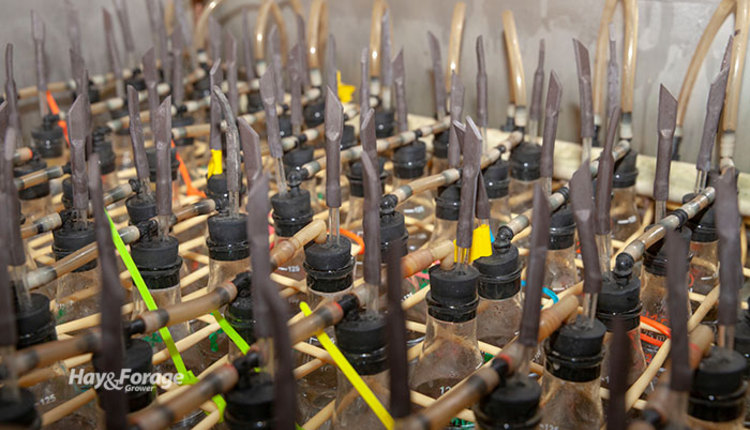
A notable characteristic of cattle is their ability to break down fiber in plant cell walls and transform it into beef and dairy products for human consumption. While this process is essential to livestock production and farm profitability, the extent of fiber digestibility ultimately depends on several factors.
In an article from Michigan State University Extension, Barry Bradford, a professor of animal science, and Kirby Krogstad, a graduate student in animal science, explain that neutral detergent fiber (NDF) is a measurement used to define the proportion of cell wall in plant tissue. Some NDF in forage is necessary to facilitate rumen function, but too much can cause excessive gut fill and limit feed intake.
Testing options
It is critical to know the NDF of a feedstuff before incorporating it into an animal’s diet. One way to do this is to utilize in vitro NDF digestibility (ivNDFD) testing.
“The ivNDFD is the proportion of NDF that is digested after some amount of time in a flask with buffered rumen fluid from a donor cow,” the authors state. “Undigested NDF (uNDF) is a related measure and is simply the portion of NDF that was not digested after some time of in vitro fermentation.”
The sum of ivNDFD and uNDF equal a forage sample’s total NDF, and it is common for laboratories to assess NDF values after 24, 30, 48, or 240 hours of simulated digestion. While this type of wet chemistry can provide an accurate NDF analysis, it can also be time-consuming and expensive. For this reason, near infrared reflectance spectroscopy (NIRS) is often offered as an alternative testing option.
“NIRS instruments bounce specific wavelengths of light off feed samples and measure the light absorbed or reflected back,” Bradford and Krogstad note. “The patterns of absorption and reflectance are indicative of the chemical composition of the feed material tested.”
Scientists have used wet chemistry in combination with NIRS to create equations to predict forage properties like NDF. Laboratories utilize a calibration database that contains thousands of reference feed samples used to evaluate forage samples sent in from producers.
Avoid inaccuracy
Although NIRS may be more affordable, it will not be more accurate in determining fiber digestibility than ivNDFD analysis. Bradford and Krogstad say one reason for this is the variability in the composition of rumen fluid from donor cows in the wet chemistry assays used as reference samples.
Errors in NIRS testing can also occur when testing an uncommon forage species that is not well-represented in the database or if a sample of forage has experienced stress from drought, heat, flooding, or pests. Therefore, Bradford and Krogstad advise producers to consider the following to safeguard an investment in NDFD analysis.
Work with laboratories that are certified by the National Forage Testing Association (NFTA). This is a voluntary certification program that monitors the testing accuracy among forage laboratories in the U.S.
Always use the same laboratory. “Different labs have different technicians, slightly different methods and materials, and different cows providing rumen fluid, so results from different labs should not be directly compared,” Bradford and Krogstad state.
Compare ivNFD within one feed type. Results from ivNDFD analysis vary among different forages. For example, alfalfa can have 40% to 45% ivNDFD after 30 hours of digestion, while grass hay may have more than 50% ivNDFD after the same amount of time. Bradford and Krogstad point out that this doesn’t necessarily mean grass hay is more digestible; it shows the two forage types behave differently in the rumen.
Compare feeds on the same digestibility timescale. “Make sure you’re comparing apples to apples,” Bradford and Krogstad assert. “Comparing a 30-hour ivNDFD to a 48-hour ivNDFD is inherently biased because the samples were digested for different amounts of time.”
Don’t use NIRS analysis for unusual samples. Most laboratories can guarantee reliable NIRS results for samples of normal corn silage and alfalfa haylage; however, their database may not be equipped with reference material for forages that are not as widely used.

Amber Friedrichsen served as the 2021 Hay & Forage Grower editorial intern. She currently attends Iowa State University where she is majoring in agriculture and life sciences education-communications and agronomy. Friedrichsen grew up on her family’s diversified crop and livestock farm near Clinton, Iowa.

